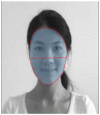Gaze Patterns in Auditory-Visual Perception of Emotion by Children with Hearing Aids and Hearing Children
- PMID: 29312104
- PMCID: PMC5743909
- DOI: 10.3389/fpsyg.2017.02281
Gaze Patterns in Auditory-Visual Perception of Emotion by Children with Hearing Aids and Hearing Children
Abstract
This study investigated eye-movement patterns during emotion perception for children with hearing aids and hearing children. Seventy-eight participants aged from 3 to 7 were asked to watch videos with a facial expression followed by an oral statement, and these two cues were either congruent or incongruent in emotional valence. Results showed that while hearing children paid more attention to the upper part of the face, children with hearing aids paid more attention to the lower part of the face after the oral statement was presented, especially for the neutral facial expression/neutral oral statement condition. These results suggest that children with hearing aids have an altered eye contact pattern with others and a difficulty in matching visual and voice cues in emotion perception. The negative cause and effect of these gaze patterns should be avoided in earlier rehabilitation for hearing-impaired children with assistive devices.
Keywords: auditory-visual perception; emotion perception; eye-movement; hearing-impaired; oral statement.
Figures



Similar articles
-
Crossmodal and incremental perception of audiovisual cues to emotional speech.Lang Speech. 2010;53(Pt 1):3-30. doi: 10.1177/0023830909348993. Lang Speech. 2010. PMID: 20415000
-
Auditory, visual, and auditory-visual perceptions of emotions by young children with hearing loss versus children with normal hearing.J Speech Lang Hear Res. 2012 Aug;55(4):1148-62. doi: 10.1044/1092-4388(2011/11-0060). Epub 2012 Jan 23. J Speech Lang Hear Res. 2012. PMID: 22271872
-
Visual attention in deaf and hearing infants: the role of auditory cues.J Child Psychol Psychiatry. 2005 Oct;46(10):1116-23. doi: 10.1111/j.1469-7610.2005.00405.x. J Child Psychol Psychiatry. 2005. PMID: 16178936
-
Seeing a Face in a Crowd of Emotional Voices: Changes in Perception and Cortisol in Response to Emotional Information across the Senses.Brain Sci. 2019 Jul 25;9(8):176. doi: 10.3390/brainsci9080176. Brain Sci. 2019. PMID: 31349644 Free PMC article.
-
Auditory, visual, and auditory-visual perception of emotions by individuals with cochlear implants, hearing AIDS, and normal hearing.J Deaf Stud Deaf Educ. 2009 Fall;14(4):449-64. doi: 10.1093/deafed/enp007. Epub 2009 Apr 27. J Deaf Stud Deaf Educ. 2009. PMID: 19398533
Cited by
-
Impact of High- and Low-Pass Acoustic Filtering on Audiovisual Speech Redundancy and Benefit in Children.Ear Hear. 2025 May-Jun 01;46(3):735-746. doi: 10.1097/AUD.0000000000001622. Epub 2025 Jan 31. Ear Hear. 2025. PMID: 39787412
-
Hearing Status Affects Children's Emotion Understanding in Dynamic Social Situations: An Eye-Tracking Study.Ear Hear. 2021 July/Aug;42(4):1024-1033. doi: 10.1097/AUD.0000000000000994. Ear Hear. 2021. PMID: 33369943 Free PMC article.
References
-
- Adams R. B., Nelson A. J. (2016). “Eye behavior and gaze,” in APA Handbook of Nonverbal Communication, eds Matsumoto D., Hwang H. C., Frank M. G. (Washington, DC: American Psychological Association; ), 335–362. 10.1037/14669-013 - DOI
-
- Agrafiotis D., Canagarajah N., Bull D. R., Dye M. (2003). Perceptually optimised sign language video coding based on eye tracking analysis. Electr. Lett. 39 1703–1705. 10.1049/el:20031140 - DOI
LinkOut - more resources
Full Text Sources
Other Literature Sources

